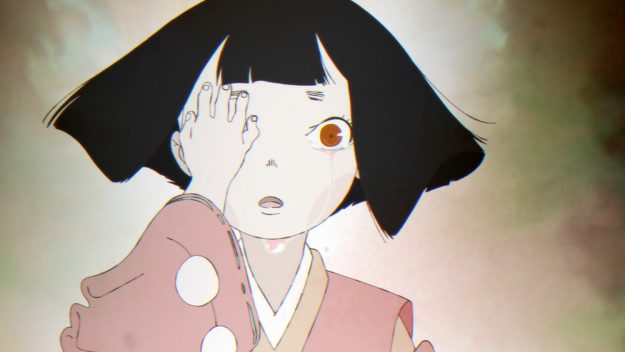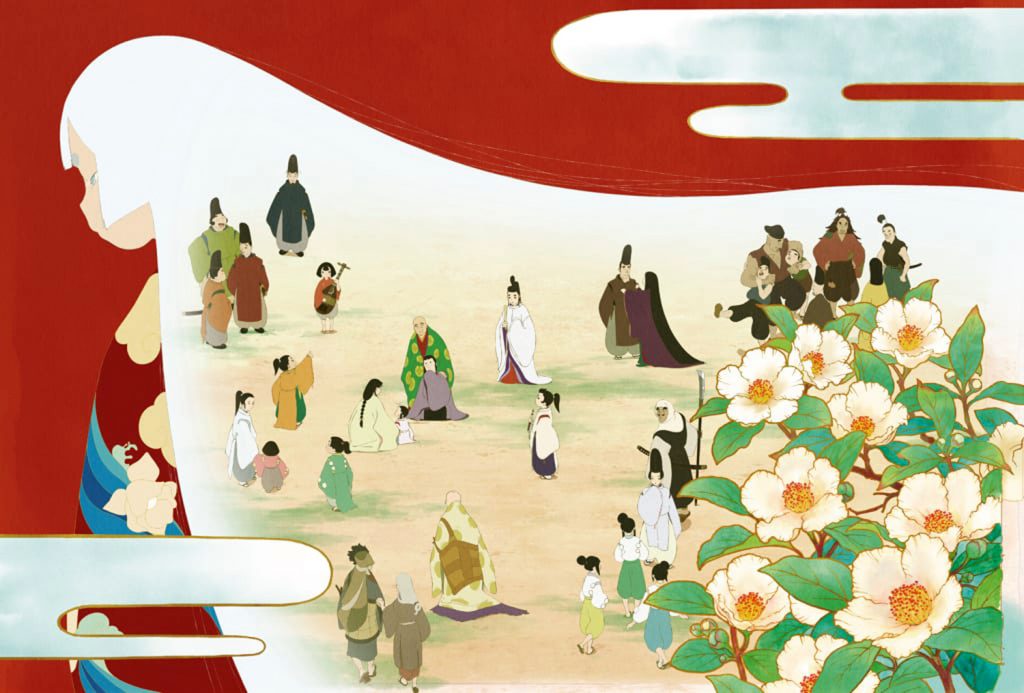Every generation grows up studying the literary classics, but it is often the dramatic adaptations that they remember the best. Just as the Broadway musical West Side Story updated Shakespeare’s Romeo and Juliet, Naoko Yamada’s 2021 anime adaptation of The Heike Story has reimagined Japan’s most famous medieval samurai epic of the same name. The new animated series condenses the lengthy 12th-century warrior tale into eleven bingeworthy episodes, currently streaming in both Japanese and English.
The original Tale of the Heike invokes fundamental Buddhist teachings to frame the fall of the powerful Heike clan during Japan’s Genpei War (1180–1185). The historic account of the Heike’s demise is set at the end of the Heian period (794–1185), when the imperial court was controlled by competing aristocratic families. During this time, the northeastern Minamoto clan began to challenge the imperial ambitions of the ruthless Taira (Heike) clan in the southwest. In the end, the Taira patriarch, Kiyomori, caused his family’s downfall through his greed, pride, and aggression. The Tale of the Heike thus chronicles the collapse of the House of Taira, told sympathetically from the loser’s perspective. Whoever said that history is written only by the victors?
The first episode opens with this solemn prose poem:
The sound of the bells at Gion temple echoes the impermanence of all things
The sal tree’s blossoms turn white to grieve him; a reminder that “all who flourish must fall.”The proud do not endure, they are like a dream on a spring night;
The mighty fall at last, they are as dust before the wind.
“Gion” is the Japanese translation of Jetavana Grove in India, where the historical Buddha taught during rainy-season retreats, and “sal trees” were present at the Buddha’s birth and death. The “white blossoms” of these trees evoke the primary color of Buddhist funerals, and “all who flourish must fall” is a quote taken directly from the Benevolent Kings Sutra. Impermanence, therefore, frames the entire Heike narrative and emphasizes the transiency of life and death, where the mighty pass “as dust before the wind.”
Impermanence also surrounds the character Biwa, whom Yamada and her team invented to narrate this medieval tale in a fresh way. Biwa is the orphan daughter of a blind Buddhist minstrel who plays the biwa lute, whose name fittingly derives from her father’s musical instrument and from the historical fact that blind Buddhist lute performers have musically recited the Tale of the Heike for centuries. Like Forrest Gump, who relives and recounts for us his first-person narrative of late-20th-century history, Biwa serves as both a contemporary witness to and a timeless reciter of the Heike’s tragic events.
Whoever said that history is written only by the victors?
To facilitate this transhistorical perspective, Yamada’s team takes poetic license and endows Biwa with extraordinary vision. Able to see both the distressing future deaths of her Heike friends and the ghosts of the past, Biwa bears witness to the Heike’s demise. Her ghostly sightings, everyday vision, and mystical premonitions transcend linear time. As a result, every episode features Biwa reliving the losses of the past by reciting the story once more in the present. This ensures the Heike’s immortality in the future. The Heike Story thus continually reminds the viewer of impermanence and keeps the message relevant to the plot.

The theme of karmic causality is also introduced in the title sequence. Right after the famous four opening lines cited above, a voice sings “The reason that flower bloomed / is that a seed fell there / And one day, when it has wilted / it will continue on as seeds again.” Life and death, action and reaction, cause and consequence inevitably propel the Heike’s combative narrative forward, and the spectator is quickly schooled in the vicious cycle of karmic retribution that escalates among Japan’s multilateral power brokers.
The cycle begins with the Taira patriarch Kiyomori, who orders his son and his samurai to protect the emperor from a powerful militia of warrior-monks from Kyoto’s Enryakuji Temple. When a stray arrow pierces Enryakuji’s portable shrine, the militant monks take revenge by burning down the Heike estate. Kiyomori’s son, on his deathbed, is cognizant of his family’s karmic debt, crying out, “The divine punishment has come to pass for father. For the Heike.”
While Kiyomori is mourning the death of his son, he finds himself in conflict with former emperor Go-Shirakawa. The fight ends with the Heike burning down Kōfukuji Temple. If Kiyomori’s karmic debt wasn’t bad enough, the flames accidentally consume the Great bronze Buddha of nearby Tōdaiji Temple as well.
By the end of his life, Kiyomori and his family have accumulated enough negative karma to cause his wife nightmares. In one sequence that illustrates her hellish dream, a fiery chariot arrives, and horse and ox demons announce: “[We have been] sent here to collect Kiyomori’s impure soul. He has set fire to temples, burning the Great Buddha [of Tōdaiji temple], and for his sins, he is now being roasted in flames. Uninterrupted suffering awaits him once he’s sunk to the lowest depths of hell.”
Ultimately, the karmic cycle of retribution exhausts itself when Enryakuji’s warrior-monks help the opposing forces take the capital of Kyoto. The Heike fleet finally falls in 1185, and Kiyomori’s wife and grandson perish below the waves, ostensibly to be reborn in the Dragon King’s Palace at the bottom of the sea.
While many of the cyclical storylines in The Heike Story end with the death of the characters involved, Buddhist renunciation is depicted as the only mechanism for truly breaking the karmic chain of self-perpetuating pain in this life. Detachment, letting go, and forgiveness are the only antidotes to vengeance and suffering, for as Lady Tokuko, Kiyomori’s daughter, remarks, “I choose to forgive them all. Perhaps that sounds sanctimonious. But someone has to offer forgiveness, or we’ll only have hatred and conflict. I’d like to believe the world isn’t all pain and suffering, so I’ll keep choosing to forgive.”
The predominantly female writers and animators on Yamada’s team helped imbue the series with a refreshing view of women’s agency, independence, and self-determination. Thus, the benefits of Buddhist renunciation are especially clear to female characters in the saga, who often take the tonsure to escape the constraints of Heian-period gender roles. Unlike the male characters Kiyomori and Go-Shirakawa, who wear Buddhist robes but never really retire from the pressures of political life, the women’s self-ordinations truly offer them a socially acceptable respite from worldly concerns.
For example, the consort Gio ordains along with a small group of laywomen who live together as nuns. Gio reflects, “Now I live in peace, according to the way I choose,” and sings,
Worldly wealth is but an illusion
What good can riches do to us?
I stand before you with a shaved head
Forgive me, I beg, for my past sins
If you deign to forgive me
Let us all live together in prayer
And be born on the same lotus in Paradise.
For lovers of world literature and film, this imaginative chronicle underscores the vital power of language—as both recited song and as written word—to ensure continued vitality for the dead as well as for the living. When Go-Shirakawa asks Lady Tokuko how she overcame the profound suffering of seeing her entire family perish, she responds, “You pray. I think of the people I love and pray for their peace and happiness in the next world. That small act is all that I can do. [Others are] also praying for the Heike we’ve lost, traveling far and wide to tell our story. And through those tales, our clan will live on.”
To put it simply, Naoko Yamada’s The Heike Story reinforces the now well-accepted axiom that manga and anime are not just for kids. Rather, her series demonstrates yet again that this modern idiom is a new and viable vehicle for creatively engaging with serious subjects, while still making them accessible and enjoyable to the general spectator. Like any other art form, when done well, anime can remind us of our humanity, draw on tradition with innovation, and in this case, reconnect us to the larger insights of the dharma. What better way to transmit and thereby preserve a practice paradoxically premised on impermanence?
♦
You can stream The Heike Story on Amazon Prime and Crunchyroll.
Thank you for subscribing to Tricycle! As a nonprofit, we depend on readers like you to keep Buddhist teachings and practices widely available.
